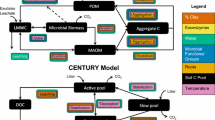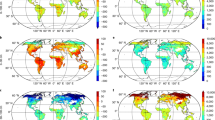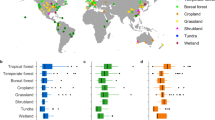Abstract
Soil organic carbon in active exchange with the atmosphere constitutes approximately two-thirds of the carbon in terrestrial ecosystems1,2. The relatively large size and long residence time of this pool (of the order of 1,200 yr) make it a potentially important sink for carbon released to the atmosphere by fossil fuel combustion; however, in many cases, human disturbance has caused a decrease in soil carbon storage3,4. Various recent estimates place the global total of soil carbon between 700 (ref. 2) and 2,946 × 1015 g (ref. 5) with several intermediate estimates: 1,080 (ref. 1), 1,392 (ref. 6), 1,456 (ref. 3), and 2,070 × 1015g (ref. 7). Schlesinger's3 estimate seems to be based on the most extensive data base (∼200 observations, some of which are mean values derived from large studies in particular areas) and is widely cited in carbon cycle studies. In addition to estimating the world soil carbon pool, it is important to establish the relationships between the geographical distribution of soil carbon and climate, vegetation, human development and other factors as a basis for assessing the influence of changes in any of these factors on the global carbon cycle. Our analysis of 2,700 soil profiles, organized on a climate basis using the Holdridge life-zone classification system8, indicates relationships between soil carbon density and climate, a major soil forming factor. Soil carbon density generally increases with increasing precipitation, and there is an increase in soil carbon with decreasing temperature for any particular level of precipitation. When the potential evapotranspiration equals annual precipitation, soil carbon density9 is ∼10 kg m−2, exceptions to this being warm temperate and subtropical soils. Based on recent estimates of the areal extent of major ecosystem complexes9,10 which correspond well with climatic life zones, the global soil organic carbon pool is estimated to be ∼1,395 × 1015g.
Similar content being viewed by others
References
Baes, C. F., Goeller, H. E., Olson, J. S. & Rotty, R. M. Am. Scient. 65, 310–320 (1977).
Bolin, B. Scient. Am. 223, 136–146 (1970).
Schlesinger, W. H. A. Rev. Ecol. System. 8, 51–81 (1977).
Jenny, H. The Soil Resource, Origin and Behavior (Springer, New York, 1980).
Bohn, H. L. J. Am. Soil Sci. Soc. 40, 468–470 (1976).
Bazilevich, N. L. in Proc. 1st int. Congress of Ecology (ed. Cave, A. J.) 47–51 (Junk, The Hague, 1974).
Ajtay, G. L., Ketner, P. & Duvigneaud, P. in The Global Carbon Cycle—SCOPE Vol. 13 (eds Bolin, B., Degens, E. T., Kempe, S. & Ketner, P.) 129–181 (Wiley, New York, 1979).
Holdridge, L. R. Science 105, 367–388 (1947).
Olson, J. S., Pfuderer, H. A. & Chan, Y.-H. Changes in the Global Carbon Cycle and the Biosphere, ORNL/EIS-109 (Oak Ridge National Laboratory, Tennessee, 1978).
Olson, J. S. & Watts, J. A. in Carbon Dioxide Review (ed. Clarke, W.) (Oxford University Press, in the press).
Jenny, H. Factors of Soil Formation (McGraw-Hill, New York, 1941).
Knonova, M. M. Soil Organic Matter (Pergamon, New York, 1966).
Vologuev, V. R. Dokl. Akad. Nauk. SSSR 60, 1–28 (1948).
Curtis, R. O. & Post, B. W. Proc. Soil Sci. Soc. Am. 28, 285–286 (1964).
Saine, G. R. Nature 210, 1295–1296 (1966).
Holdridge, L. R. Life Zone Ecology (Tropical Science Center, San Jose, 1964).
MacMahon, J. A. & Wieboldt, T. F. Great Basin Natur. Mem. 2, 245–257 (1978).
Steila, D. Prof. Geogr. 18, 358–364 (1966).
Tosi, J. A. Econ. Geogr. 40, 174–181 (1964).
Hahn, G. J. & Shapiro, S. S. Statistical Models in Engineering (Wiley, New York, 1968).
Schlesinger, W. H. in The Role of Terrestrial Vegetation in the Global Carbon Cycle: Methods for Appraising Changes (Wiley, New York, in the press).
Manabe, S. & Wetherald, R. T. J. Atmos. Sci. 37, 99–118 (1980).
Whittaker, R. H. & Likens, G. E. in Carbon and the Biosphere (eds Woodwell, G. M. & Pecan, E. V.) 281–302 (Technical Information Center, Oak Ridge, 1973).
Walter, H. Vegetation of the Earth (Springer, New York, 1973).
Author information
Authors and Affiliations
Rights and permissions
About this article
Cite this article
Post, W., Emanuel, W., Zinke, P. et al. Soil carbon pools and world life zones. Nature 298, 156–159 (1982). https://doi.org/10.1038/298156a0
Received:
Accepted:
Issue Date:
DOI: https://doi.org/10.1038/298156a0
- Springer Nature Limited
This article is cited by
-
C:N:P stoichiometric characteristics and drivers of surface soil in the drylands of China
Environmental Earth Sciences (2024)
-
Altitudinal and aspect-driven variations in soil carbon storage potential in sub-tropical Himalayan forest ecosystem: assisting nature to combat climate change
Environmental Monitoring and Assessment (2024)
-
Soil organic carbon stocks in native forest of Argentina: a useful surrogate for mitigation and conservation planning under climate variability
Ecological Processes (2024)
-
Vegetation as a key driver of the distribution of microbial generalists that in turn shapes the overall microbial community structure in the low Arctic tundra
Environmental Microbiome (2023)
-
Nitrogen deposition weakens the stimulatory effect of Moso bamboo (Phyllostachys edulis) leaf litter on soil CO2 emissions
Journal of Soils and Sediments (2023)





